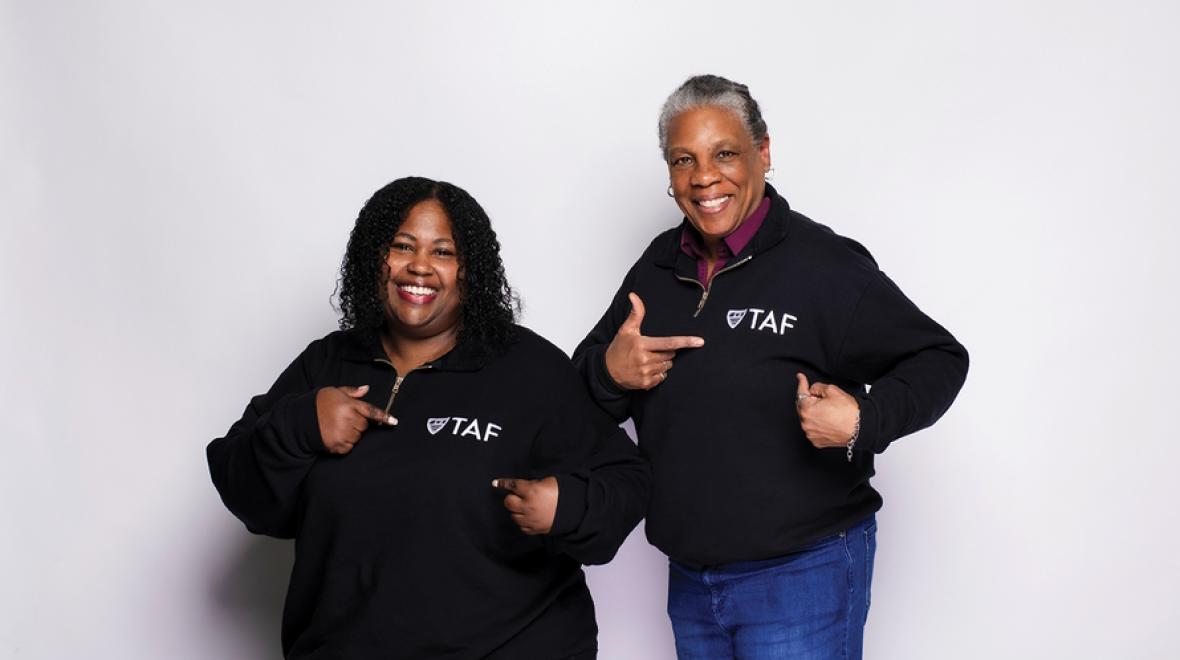ParentMap’s 2023 Superheroes for Washington Kids and Families

Photo:
Sherry Williams and Trish Millines-Dziko. Photo credit: Will Austin
The Equalizers
Trish Millines-Dziko cofounded the Technology Access Foundation (TAF) in 1996 with the vision of teaching children of color the information technology skills that would enable them to go on to college. TAF does this by building collaborative partnerships within public education to expand access to transformative learning pathways as well as broaden opportunities to eliminate race-based disparities for students and teachers of color. Millines-Dziko would tell you that our current education system is broken and TAF’s mission is to fix it, to create educational justice.
Millines-Dziko was first honored as a ParentMap Superhero for her work at TAF in 2008. Since then, the organization has evolved its STEMbyTAF model to fully transform public schools and improve teacher diversity and the retention of teachers of color in Washington state. Millines-Dziko nominates her longtime TAF colleague Sherry Williams, executive director of operations, as a ParentMap Superhero for 2023.
Why did you nominate Sherry as a superhero for Washington state families?
Trish Millines-Dziko: Sherry is really the other half of TAF. Everything that we are as a culture is Sherry. We’ve known each other almost 30 years. She’s been with TAF since it was 4 months old. She’s a great person, and people should know her.
How would you describe the TAF culture?
Sherry Williams: So, it’s people first: First it’s our kids, but in order to take care of the kids, we have to take care of each other. And so how do we do that? We treat each other as human beings, with love and care and thoughtfulness. And then we work hard together. When times get tough, we know that we care about each other and that we will make it through.
Millines-Dziko: A lot of times, we’ll get younger people coming to work at TAF, and I always say, “I’m not the person who is going to develop you. You need to go to Sherry.” If you have a plan, I can go over the plan with you. But if you’re starting from scratch or you’ve got some deeper things to work on, go to Sherry. She’s the one.
What do you envision for TAF in the next few years?
Williams: Serving more babies and teachers. Expanding TAF outside of Washington state is really what I want to see, because there’s a need, not just here, but all over the nation, for students of color and teachers of color. So, I want to spread the STEMbyTAF model.
What does the organization need in order to expand?
Williams: Money. And more talented people who get the passion of TAF and want to come work here and do the hard work. That’s what we really need.
Where do you find talented teammates?
Williams: A mix of places, but a lot of times it is through word of mouth, because we’re really looking for the right person. Not just anyone with the technical skills — they have to have passion.
Millines-Dziko: Working at TAF is about more than being an educator — it’s a movement. We’re in a movement right now, and you have to “know your why.” That’s what Sherry’s talking about when she says passion. Because when the gatekeepers come and all of the barriers go up — which they do on a regular basis — if you don’t know why you’re there, you’re going to leave. This work is not even close to easy, because we’re working with adult human beings to impact young people.
Who are your partners in this work?
Millines-Dziko: I would say our current district partners are the ones that really got us launched in this work. And we want more district partners. We have 13 university partners to help us with the teachers of color. We want more of them.
Of course, we have corporate partners who fund us. And there are some foundations that consider us to be partners, not just grantees. I would consider anybody who is willing to sit down and do the work with us and evolve with us as a partner.
We have a number of really good corporate partners that support our work: Costco, Comcast, Amazon, Alaska Airlines, Google, Microsoft....
Pre-COVID, we averaged about 250–300 volunteers a year, and a lot of them came from the ranks of our corporate partners. Then COVID came, and that number went down, but they still volunteered online, which was good. We got this whole new set of people to volunteer because of that. Now, we’re back in person, and it’s picking up.
How many people would you say have been served by TAF?
Millines-Dziko: For those first 10 years, we educated more than 500 teenagers, and then about probably another 400 or 500 K–8 kids through our program.
But we changed, because what was happening with our teenagers is, while they were getting technical internships and doing great, they were tracked in the wrong math and science tracks at high school. So, when they got into college, they couldn’t take their computer science or engineering classes right away. They had to take remedial math classes. And that’s when we said, “Okay, we’ve got to fix this.”
We created our own academic model with the support of educators and opened up TAF Academy in 2008 with Federal Way [Public Schools]. We’ve just been going since then.
Williams: We have eight school partners now and we’re trying to grow more. COVID kind of stopped us in our tracks. Our goal was three new schools per year. We opened two schools the year of COVID. So, we got to get back on track.
Millines-Dziko: Right now, if you look at the numbers, we’re impacting about 3,000 kids a year. Then, a tertiary impact is through our teachers of color. And that’s another 15,000 or more per year.
How is the TAF model designed to help kids and teachers?
Millines-Dziko: We don’t provide curriculum. What we do is help teachers deliver STEM curriculum better. And when it comes to assessing kids, we help them do it in a more authentic way. The problem with the state test is that it is timed, number one; it’s in one span of time and is based on the expectation that every teacher you ever had delivered all of the content for all of the standards — and that you retained all of it. And now, boom! It’s too much.
But the problem is, when parents see high test scores, they think it’s a good school. So, then you have all the people who have money and means who don’t want to pay for private school. They go to the school that has the best test scores. But guess what? Their kids aren’t getting any better of an education than the kids who have lower test scores. It’s just that they happen to pass these tests. And many of the parents pay to have their kids trained on how to take the test. There are trick questions on the test. Why do you need trick questions? We’re trying to help kids learn. We’re not trying to put them through a gauntlet!
We work with our teachers to do authentic assessments, but the teachers don’t work for us. They work for the district. And the district says what the state says, which is that the kids have to pass the test. So, our teachers are kind of torn. We want to propose a way to do authentic assessments that everybody can do, have it be consistent, have it be objective. We’re trying to build a system like that.
Up next: The Artisan









